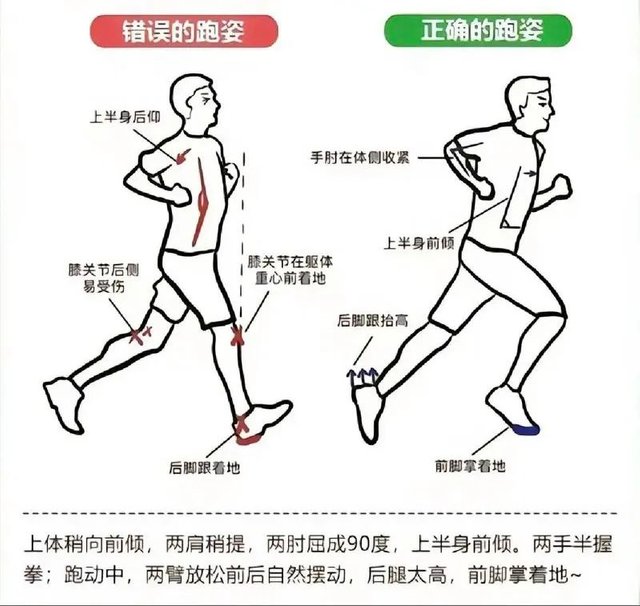跑步与膝盖健康:正确的方法才能避免损伤
很多人误以为跑步伤膝盖,尤其是在看到周围朋友受伤或听闻相关的报道时。然而,实际情况并非如此,跑步本身并不会导致膝盖损伤,真正的罪魁祸首是错误的跑步方式。只要掌握正确的方法,跑步不仅不会伤膝盖,还能为身体带来诸多益处。本文将探讨如何通过科学的跑步技巧和合理的训练规划,确保膝盖不受伤害。

为什么有人认为跑步伤膝盖?
这种观念来源于对跑步和膝盖损伤的片面理解。的确,如果采用错误的跑步姿势或过度训练,膝盖会承受过大的压力,进而导致损伤。然而,科学的跑步方式不会对关节造成长期伤害,反而能够增强腿部肌肉和膝盖的韧性,改善关节灵活度。
正确的跑步姿势是关键
跑步的姿势直接影响着身体的受力情况。跑姿不当会让地面的反作用力过多集中在膝盖上,长期积累后容易引发损伤。以下是几个关键的正确跑姿要点:
- 脚掌着地:跑步时应避免脚跟重重落地,建议采用前脚掌或中脚掌着地,以分散地面的反冲力。
- 膝盖微屈:保持膝盖微微弯曲,可以有效吸收冲击,减轻膝盖负担。
- 身体前倾:身体略微前倾,可以利用重力减少对膝盖的压力,同时保持上身稳定,避免不必要的晃动。
- 手臂摆动:手臂自然摆动有助于保持跑步节奏和身体平衡。手肘弯曲成90度,随着步伐前后摆动。

适当的跑步强度与休息
过度训练或突然增加跑步量是膝盖损伤的另一个主要原因。跑步者应循序渐进地增加跑量,避免在短时间内挑战过高的目标。每次跑步时长应控制在40-60分钟,心率保持在每分钟150左右是比较理想的状态。此外,每周应安排足够的休息时间,建议跑一休一或跑二休一,以让身体有时间恢复。
热身与拉伸的重要性
无论是跑步前的热身还是跑步后的拉伸,都能大大降低膝盖损伤的风险。跑前的热身能够激活肌肉和关节,让身体逐渐进入运动状态。尤其是在寒冷的天气下,热身显得尤为重要。跑后拉伸则可以帮助肌肉恢复,促进血液循环,减少乳酸堆积,避免肌肉酸痛。
如何避免膝盖损伤:科学的训练计划
为了减少跑步对膝盖的影响,建议采用以下科学的训练方法:
- 跑步时间的控制:每次跑步控制在40-60分钟内,避免过长时间的高强度跑步。
- 逐步增加跑量:避免一次性增加过多跑量,每周增加的跑量不要超过10%。
- 休息日的重要性:即使身体感到状态良好,也需要定期休息,让关节和肌肉有时间恢复。
- 加强腿部力量训练:通过深蹲、弓步等力量训练,增强大腿和膝盖周围的肌肉,提供更多的支撑。
- 定期检查跑鞋:跑鞋的选择非常重要,鞋底过度磨损的跑鞋会影响跑步姿势,增加膝盖的负担。

结论
跑步本身并不会伤害膝盖,错误的跑步方式才是导致损伤的主要原因。只要掌握正确的跑步姿势,合理安排训练计划,跑步不仅不会伤膝盖,反而能够提高整体健康水平。科学跑步,让健康伴随每一步!
Many people mistakenly believe that running is harmful to the knees, especially after seeing friends get injured or hearing related reports. However, the reality is that running itself does not cause knee damage. The real culprit is incorrect running techniques. As long as you adopt proper methods, running will not only be safe for your knees but also bring numerous health benefits. This article will explore how to ensure your knees stay injury-free by applying scientific running techniques and reasonable training plans.
Why Do Some People Think Running Hurts the Knees?
This notion stems from a partial understanding of the relationship between running and knee injuries. Indeed, if you run with improper form or overtrain, your knees may bear excessive pressure, leading to injuries. However, when done right, running does not cause long-term harm to your joints. Instead, it can strengthen leg muscles and knee resilience, enhancing joint flexibility.
Correct Running Posture Is Key
Your running posture directly affects how your body absorbs impact. Incorrect form can concentrate too much of the ground's reaction force on the knees, leading to injuries over time. Here are some key points for proper running posture:
- Footstrike: Avoid landing heavily on your heels. Use a forefoot or midfoot strike to distribute the impact force.
- Slight Knee Bend: Keeping your knees slightly bent helps absorb shock and reduces the load on your knees.
- Forward Lean: A slight forward lean helps utilize gravity to ease pressure on the knees and maintain upper body stability.
- Arm Swing: A natural arm swing helps maintain running rhythm and body balance. Keep your elbows bent at 90 degrees, moving them in sync with your steps.
Appropriate Running Intensity and Rest
Overtraining or suddenly increasing your mileage is another primary cause of knee injuries. Runners should gradually increase their running volume to avoid overwhelming their bodies. Each run should last between 40-60 minutes, with an ideal heart rate of around 150 beats per minute. Additionally, ensure to incorporate adequate rest days, such as alternating between running days and rest days, allowing the body time to recover.
The Importance of Warming Up and Stretching
Both pre-run warm-ups and post-run stretches significantly reduce the risk of knee injuries. Warming up before running activates muscles and joints, gradually preparing the body for exercise. This is especially important in colder weather. Post-run stretching helps muscles recover, promotes blood circulation, reduces lactic acid buildup, and prevents muscle soreness.
Avoiding Knee Injuries: A Scientific Training Plan
To minimize the impact of running on your knees, it is recommended to follow these scientific training methods:
- Control Running Time: Keep each run between 40-60 minutes to avoid prolonged high-intensity running.
- Gradually Increase Mileage: Avoid abrupt increases in mileage, and limit weekly mileage increases to no more than 10%.
- Incorporate Rest Days: Even if you feel good, take regular rest days to allow your joints and muscles time to recover.
- Strengthen Leg Muscles: Incorporate exercises like squats and lunges to strengthen the muscles around the thighs and knees, providing more support.
- Regularly Check Your Running Shoes: The right shoes are crucial. Worn-out shoes can affect your running posture, placing extra strain on your knees.
Conclusion
Running itself does not harm your knees; it is improper running techniques that cause injuries. By mastering the correct running posture and organizing a balanced training plan, running will not only protect your knees but also improve your overall health. Run smart, and let health accompany every step!